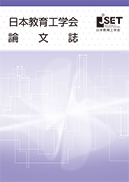Volume 43, Issue 2
Displaying 1-8 of 8 articles from this issue
- |<
- <
- 1
- >
- >|
Paper
-
Article type: research-article
2019 Volume 43 Issue 2 Pages 91-103
Published: September 30, 2019
Released on J-STAGE: September 30, 2019
Download PDF (448K) -
 Article type: research-article
Article type: research-article
2019 Volume 43 Issue 2 Pages 105-115
Published: September 30, 2019
Released on J-STAGE: September 30, 2019
-
Article type: research-article
2019 Volume 43 Issue 2 Pages 117-125
Published: September 30, 2019
Released on J-STAGE: September 30, 2019
Download PDF (422K)
Paper on Educational Practice Research
-
Article type: research-article
2019 Volume 43 Issue 2 Pages 127-138
Published: September 30, 2019
Released on J-STAGE: September 30, 2019
Download PDF (497K) -
Article type: research-article
2019 Volume 43 Issue 2 Pages 139-149
Published: September 30, 2019
Released on J-STAGE: September 30, 2019
Advance online publication: July 25, 2019Download PDF (417K) -
Article type: research-article
2019 Volume 43 Issue 2 Pages 151-165
Published: September 30, 2019
Released on J-STAGE: September 30, 2019
Advance online publication: August 21, 2019Download PDF (426K)
Technical Information
-
Article type: research-article
2019 Volume 43 Issue 2 Pages 167-173
Published: September 30, 2019
Released on J-STAGE: September 30, 2019
Download PDF (576K) -
Article type: research-article
2019 Volume 43 Issue 2 Pages 175-183
Published: September 30, 2019
Released on J-STAGE: September 30, 2019
Download PDF (344K)
- |<
- <
- 1
- >
- >|
